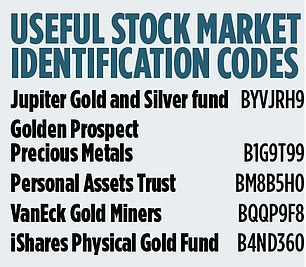
Golden ticket: The new Wonka movie starring Timothee Chalamet
The new Wonka movie starring Timothee Chalamet isn’t the only golden ticket in town. This week the gold price hit a record high, coming in at above $2,100 an ounce and making investors wonder if they should add a little lustre to their portfolios.
Whether you hold it as bullion, invest via a fund or dabble in gold mining, the precious metal holds a unique appeal despite some obvious limitations.
‘The last time I checked, you can’t pay for your shopping with gold,’ says Rob Burgeman at wealth manager RBC Brewin Dolphin. ‘And unlike other investments such as shares, it offers no form of income. It can also be quite volatile to world events.’
Nonetheless, Burgeman believes that gold usually warrants a place in most people’s portfolio. The question is, how much should you hold, and how? And as prices are at a record high, is this the worst time to buy in?
Unique characteristics
Anyone who lived through Germany’s hyperinflation in the 1930s understood what gold can do. As the currency lost value every day, those who had bought gold with their marks were able to store their wealth safely, rather than ending up with wheelbarrows full of worthless notes.
The metal performs a similar, although less dramatic, function today. Max Belmont, portfolio manager at First Eagle Investments, which runs a gold fund, says that its ability to preserve real purchasing power through extreme events means investors see it as a safe haven.
The more pessimistic you are about the state of the world, the more likely you are to want to hold gold in the hope that the price will go up. But many people use it as a diversifier to protect their portfolios from extreme movements, whatever their feeling about the economy.
However, gold itself can be a volatile investment. Global uncertainty tends to push the price up over the long term, but over the short term there can be wide fluctuations.
Higher interest rates also tend to push the price down. That is because gold does not produce an income. When rates are low, that is not so keenly felt by investors. But when investors can get a few percentage points on their money simply by putting it in a savings account, the lack of income offered by gold becomes more of a turn-off.
Adrian Ash, who runs BullionVault, which holds physical gold for investors, says that while gold does not always supply an effective hedge in the short-term, it does over longer periods. ‘It’s no better than a coin toss whether the price of gold will advance in the opposite direction to the UK stock market. But on a longer time horizon, gold typically does well when other assets do badly.’
Why gold is on a roll
Gold’s record high price this week is due to a large degree to geopolitical tensions, in particular in Ukraine and the Middle East. In the week after the Hamas attacks on Israel, the gold price leapt up six per cent.
Expectations that interest rates may have peaked are also pushing up the price of gold.

The weakening US dollar also influences the price, according to Andrew Prosser, head of investments at ETF platform Investengine. The gold price is measured in US dollars, so if the dollar is weaker it boosts the purchasing power of non-US gold buyers. What’s more, central banks around the world are still snapping up the precious metal. Last year, more than 1,000 tons of gold were purchased by central banks and treasuries. Another 800 tons were bought from January to September this year.
Robert Minter, director of ETF Investment Strategy, at investment group Abrdn says this buying spree is unlikely to stop. ‘It is part of a advance to diversify away from the US dollar,’ he says. Minter adds that the majority of the purchases are concentrated in the so-called Brics countries – Brazil, Russia, India, China and South Africa.
Ash at BullionVault believes the price may be advance strengthened by a traditional January buying spree among investment managers. He says that gold prices have risen in seven out of the last ten Januaries due to this factor.
‘Portfolio managers look ahead to reposition their spread of assets,’ he says. ‘They tend to focus on the coming year’s risks and threats, and many of them pick gold as a kind of investment insurance.’
But if interest rates remain higher for longer than expected and geopolitical tensions ease, gold may lose its sheen. Max Belmont at First Eagle, says that doesn’t stop it serving its purpose as a ‘source of resilience in a wide variety of adverse circumstances’.
‘We don’t forecast the price of gold. We utilize it as a strategic position against the frailties that can impact the marketplace,’ he says.
Some links in this article may be affiliate links. If you click on them we may earn a small commission. That helps us fund This Is Money, and keep it free to use. We do not write articles to encourage products. We do not allow any commercial relationship to affect our editorial independence.



